The
semantic structure of the word. Types of lexical meaning.
The branch
of Linguistics which studies the meaning of different linguistic
units is called Semantics.
The
part of Lexicology which studies the meaning and the development of
meaning of words is called Semasiology.
There
are different approaches to the problem of word meaning: 1) The
referential,
or denotational
approach
is characterized by the thought that (тем
что)
the essence (суть)
of meaning lies in the interconnection and interdependence between:
the word as the soundform, the referent, and the concept. Here
meaning
is the realization of the concept/notion by means of a definite
language system. 2)The functional,
or contextual
approach
is characterized by the idea that the meaning of a linguistic unit
may be studied only through its relation to other linguistic units.
Thus, meaning
is understood as the function of linguistic signs, or their use in
context.
Word
meaning is represented by different types of meaning: grammatical,
lexical, lexico-grammatical.
Grammatical
meaning
is the component of word meaning, recurrent in identical sets of
individual forms of different words. It is expressed by:
-
word-form (such as books,
girls, boys – the meaning of plurarity; looked, asked – tense
meaning); -
the position of the word in
relation to other words (e.g. He sings well, She dances badly –
‘sings’ and ‘dances’ are found in identical positions
between a pronoun and an adverb, their identical distribution proves
that they have identical gr.m.)
Lexico-grammatical
meaning
of the word is the common denominator (знаменатель)
to all the meanings of the words belonging to a certain
lexico-grammatical class or group of words.
Lexical
meaning
is the component of word meaning recurrent in all the forms of the
word. The word forms go, goes, went, gone, going have different
gr.m., but they have one and the same l.m. ‘the process of
movement’.
The main
component of L.m.
are:
-
the
denotational
meaning
of words is the same for all the speakers. It is the realization of
the concept by means of the given language. -
The
pragmatic
aspect
of l.m. is the part of meaning, that conveys information on the
situation of communication: information on the ‘time and space’
relationship of the participants, information on the participants in
the given language community, information on the register of
communication. -
The
connotational
meaning
conveys the speaker’s attitude toward what he is speaking about.
There are 4 main types of connotations: a) The emotional
connotation
expresses human emotions and feelings (e.g. daddy, father); b) The
evaluative
connotation expresses approval or disapproval (e.g. agent and spy,
planning and scheming=planning secretly); c) The intensifying
connotation adds emphasis (усиление)
to the meaning. (e.g. enormous, huge, tremendous=very); d) The
stylistic
connotation determines the functional speech style characteristic of
the word usage (dad-father-parent; colloquial-neutral-bookish).
Polysemy is the
abbility of a word to have more than one m-g. The causes of the
development of polysemy in Eng. are:1) the great amount of
monosyllabic root words; 2) an abundance of words of long duration,
which in the course of time were used to express more new m-gs thus
becoming highly polysemantic. Monosemantic words, i.e. words which
have only one m-g form. They are mostly names of birds
(blackbird,swallow), animals (walrus, weasel), fishes (ruff, perch) &
special terms (systole, phoneme). The bulk of Eng. words are
polysemantic,i.e. they have several m-gs. The m-g in speech is
contextual. In a definite context any polysemantic word expresses
only one m-g. A word in one of its m-g in which it is used in speech
is called a lexico-semantic variant of a word. The semantic structure
of a polysemantic word presents a set of interrelated &
interdependent lexico-semantic variants. WE distinguish on the
synchronic level: — the basic (major) & the minor; — the central
& the marginal; -direct & transferred(figurative); -. Every
LSV is connected with the major m-g due to the existence of the
common semantic components/ semes. The seme is the smallest further
indivisible unit of m-g, the smallest unit of the plan of content.
The analysis of the m-g into these components, or semes, is called
the componential analysis.
Соседние файлы в папке Гос филология
- #
- #
- #
- #
- #
- #
- #
- #
- #
- #
- #
Слайд 1Semantics
Semantics (semasiology) is a branch of lexicology that is devoted to
the study of word meaning.
the semantics of a word = the meaning of a word
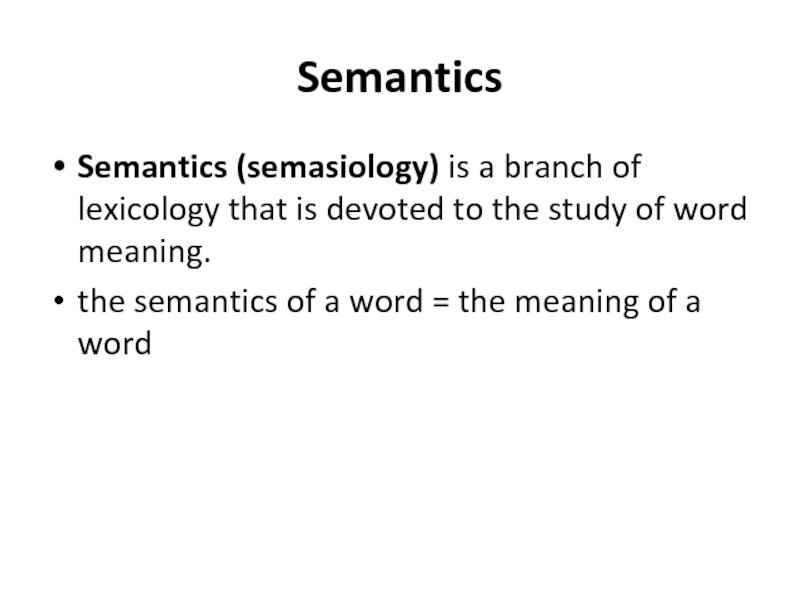
Слайд 2Meaning
a component of the word through which a concept is communicated,
thus enabling this word to denote real objects, qualities and abstract notions.
Two aspects of the word:
the outer aspect, the material side of the word (план выражения) (i.e. its sound form)
the inner aspect, the ideal side of the word (план содержания) (its meaning).
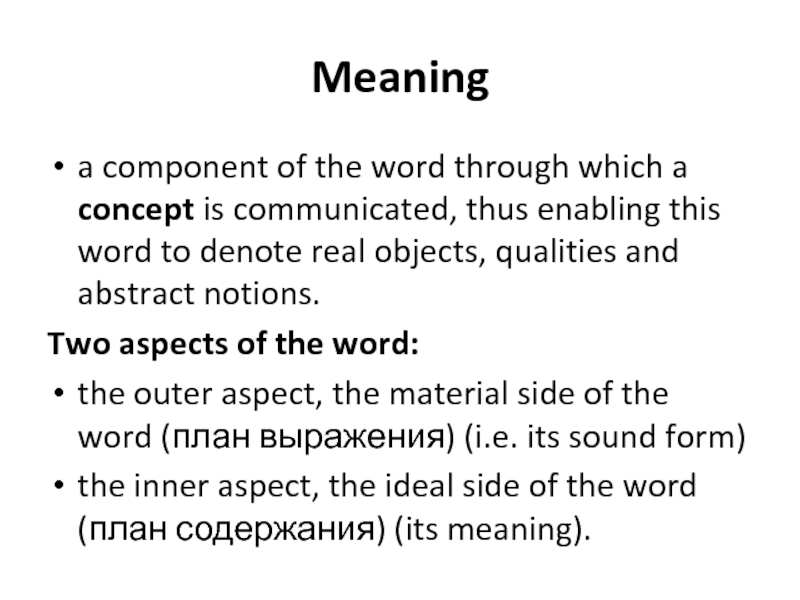
Слайд 3Types of meaning
Grammatical meaning: tables, students, houses, jokes — the grammatical
meaning of plurality.
The component of meaning recurrent in identical sets of individual forms of different words. E.g. the tense meaning (went, answered, wrote), the case meaning (parents’, sister’s, student’s, etc.).
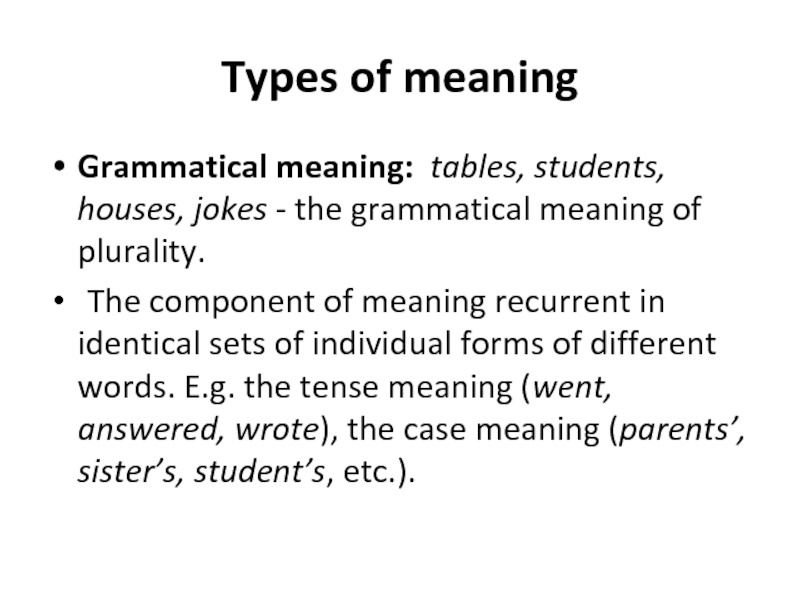
Слайд 4Types of meaning
Lexical meaning is identical in all the forms of
the word. E.g. write, writes, wrote, writing, written.
The meaning proper to the given linguistic unit in all its forms and distributions
Both the lexical and grammatical meanings make up the word-meaning as neither can exist without the other.
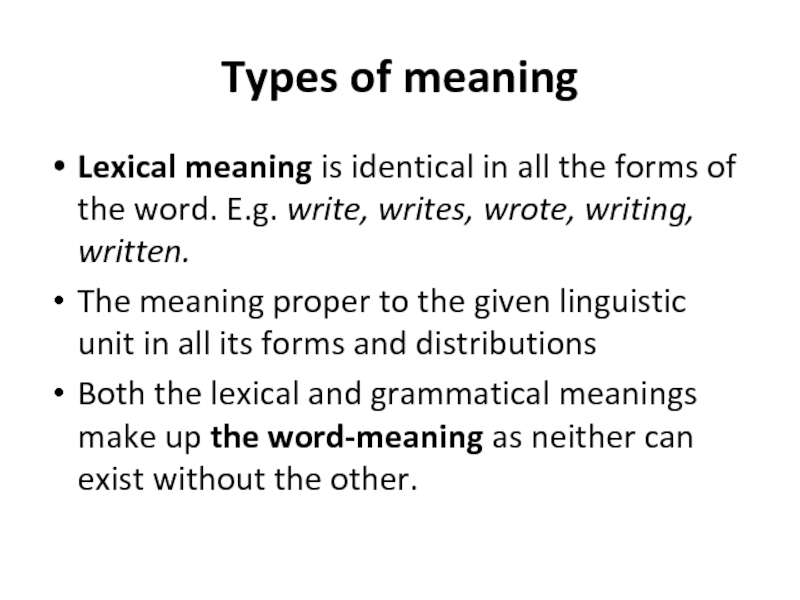
Слайд 5The components of meaning
the denotative component (denotation)
the connotative component (connotation)
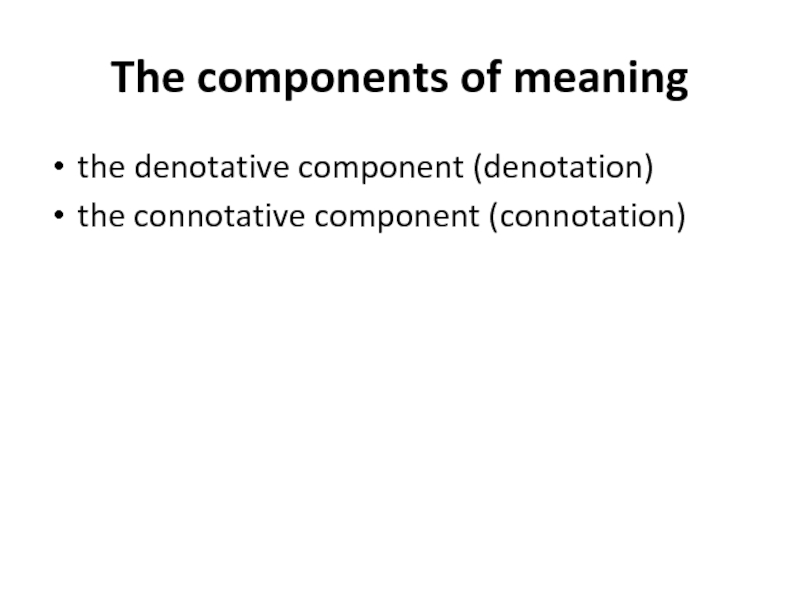
Слайд 6The denotative component of meaning (denotation)
is the principal part of meaning
that makes communication possible. It expresses the conceptual content of a word.
lonely: alone, without a company
notorious: well known
celebrated: well known
to adore: to love
to glare: to look
to glance: to look
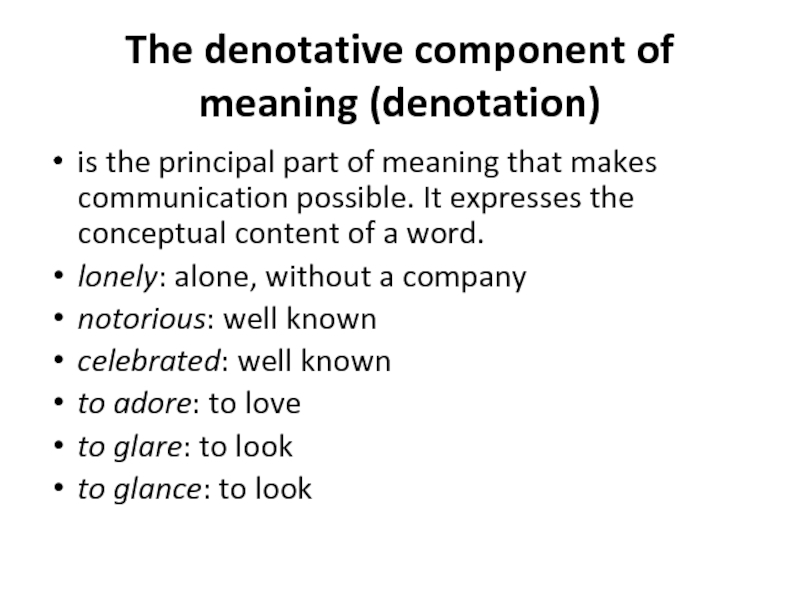
Слайд 7The connotative component of meaning (connotation)
is what the word implies in
addition to its denotative meaning. It is the set of associations that a word’s use can evoke.
E.g. a hovel: “a small house” + “miserable, dirty, in bad repair, unpleasant to live in”.
Types of connotation:
emotive
evaluative
expressive (intensifying)
pragmatic (i.e. connotation of duration, manner, cause, etc.)
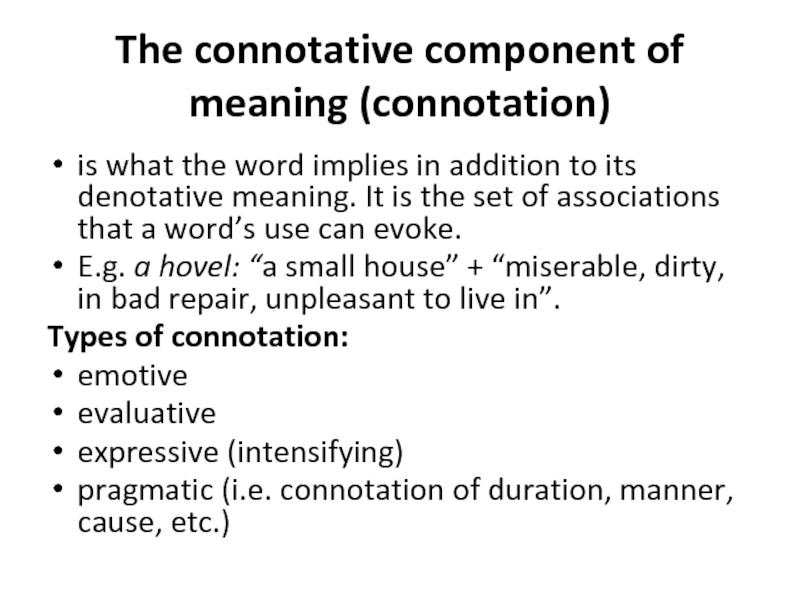
Слайд 8The connotative component
lonely: unhappy (emotive connotation)
notorious: about something bad (evaluative connotation,
negative)
celebrated: about something good (evaluative connotation, positive)
to adore: deep feeling (expressive connotation)
to glare: steadily (connotation of duration) + in angry, fierce way (emotive connotation)
to glance: briefly (connotation of duration)
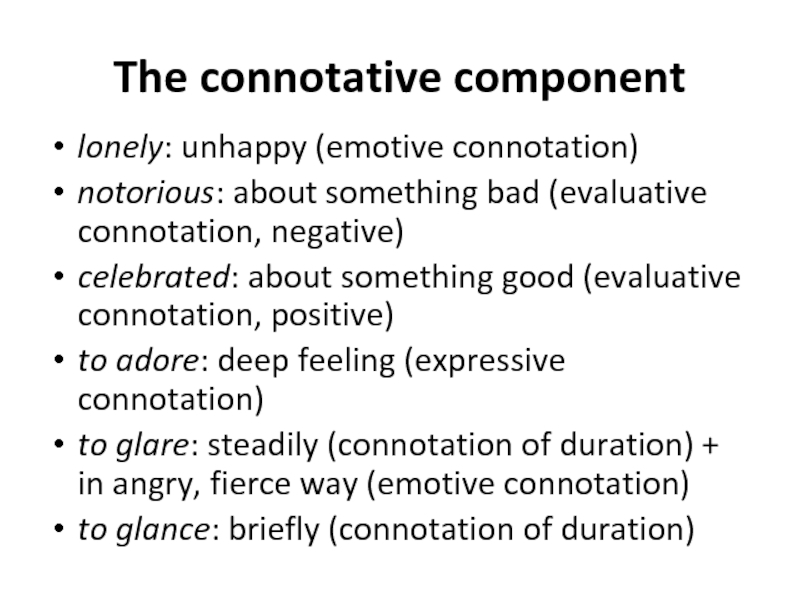
Слайд 9Denotative and connotative components
Often a word’s connotation is fully explained in
the dictionary.
Otherwise it can be realized through the context.
E.g. Los Angeles is notorious for its smog.
Denotative and connotative components make up the semantic structure of a word.
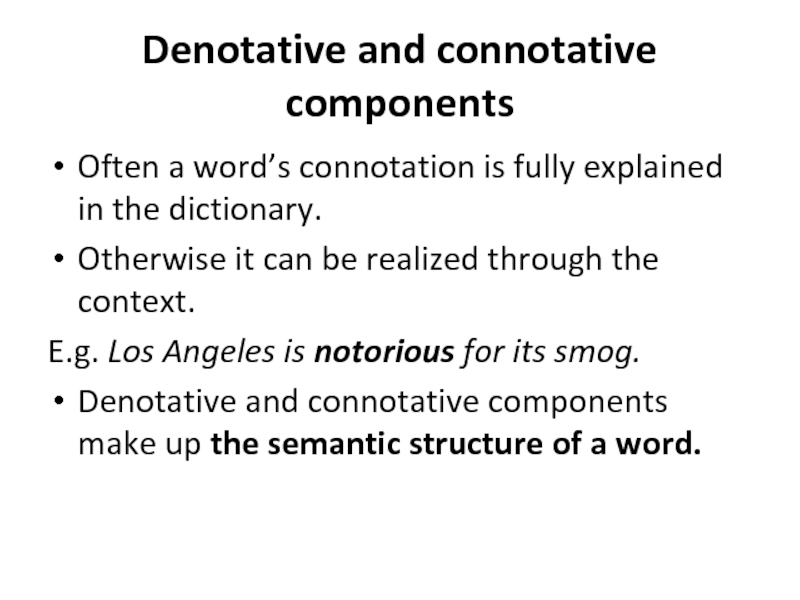
Слайд 10Semantic Transfer
The process of development of a new meaning (or a
change of meaning) is termed transference.
Types of transference:
metaphor
metonymy
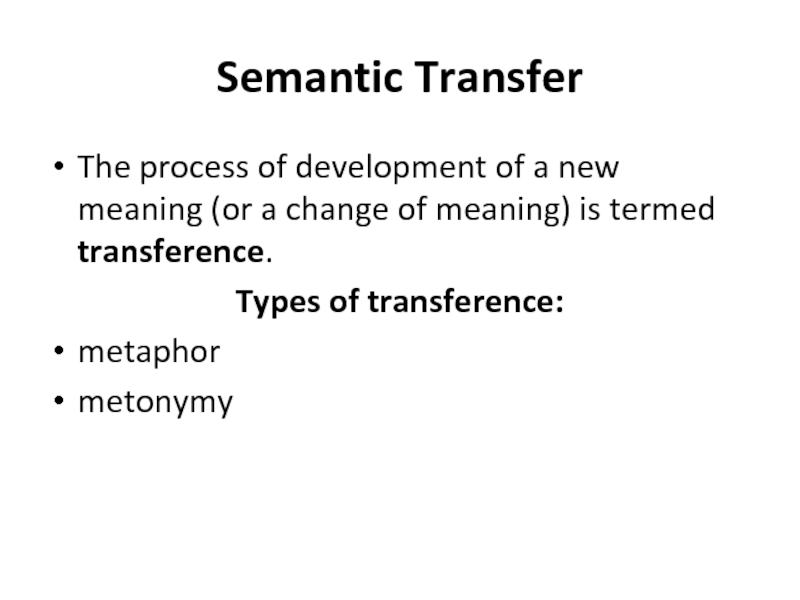
Слайд 11Metaphor
Metaphor is a type of transference based on the similarity of
the objects, qualities or phenomena denoted by the words.
Types of metaphor:
similarity of shape: thus we can speak of the eye of a needle
position: head of a tree
function: hands of a clock, etc.
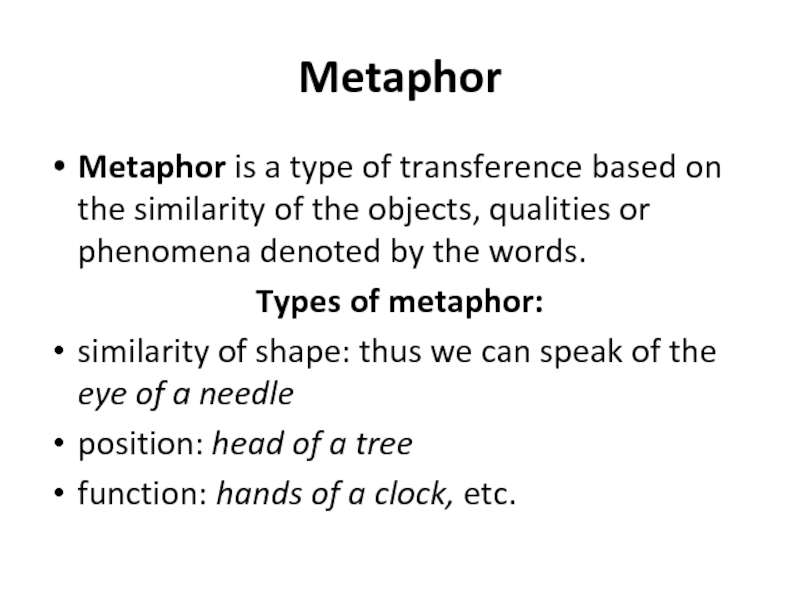
Слайд 12Metonymy
is based on the contiguity (смежность) of the objects, qualities or
phenomena denoted by the words.
Types of metonymy:
The name of the place — its inhabitants: school
Quality — the subject of this quality: beauty Material — the product made of this material: bronze, clay, silver
Animal – the meat of this animal: fowl, turkey Action – the subject of the action: safeguard, support
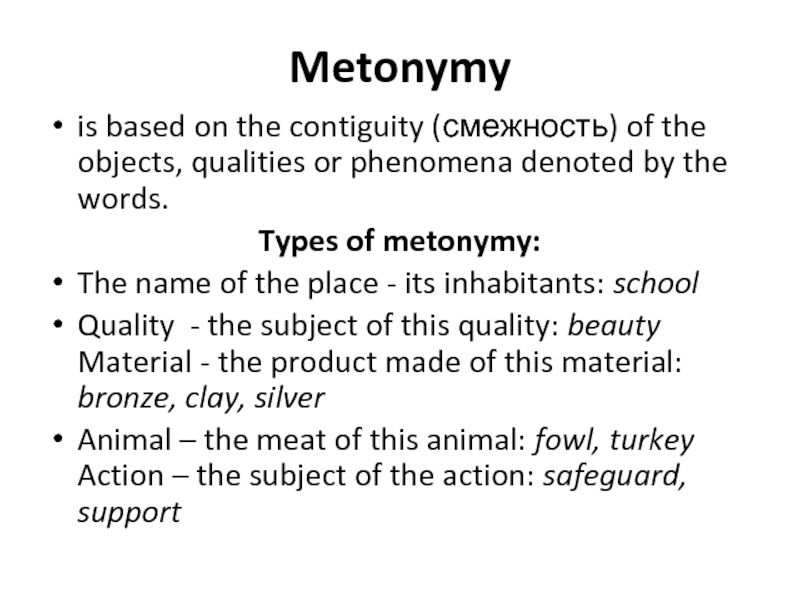
Слайд 13
Results of semantic change
Change of the denotative component:
broadening (generalization) of meaning:
bird, pipe
narrowing (specialization) of meaning: hound, girl
Change of the connotative component:
Elevation of meaning (the improvement of the connotative component of meaning): minister, knight
Degeneration of meaning (the acquisition by the word of some derogatory emotive charge): boor, silly
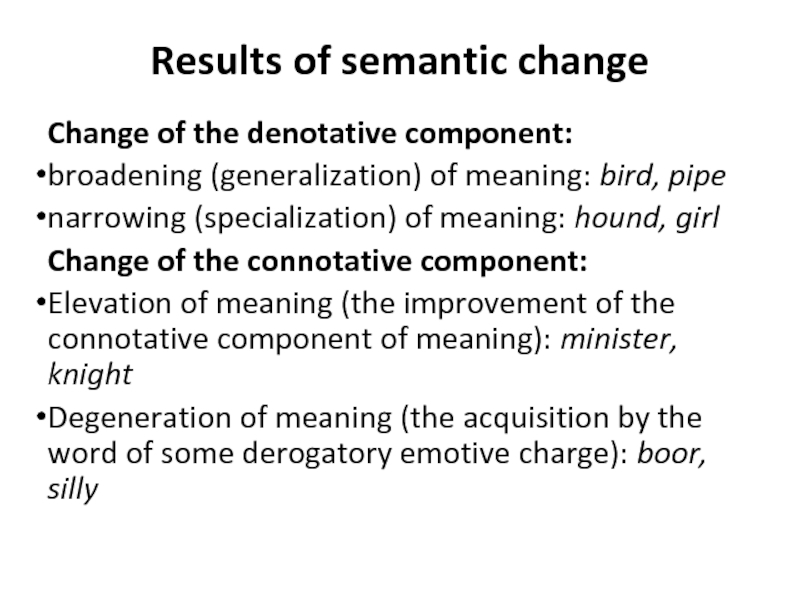
Слайд 14
Polysemy
Polysemy is the ability of a word to possess several meanings.
E.g. bright: ‘shining’; ‘intelligent’.
A word having several meanings is called polysemantic.
Words having only one meaning are called monosemantic (morpheme, antibiotics).
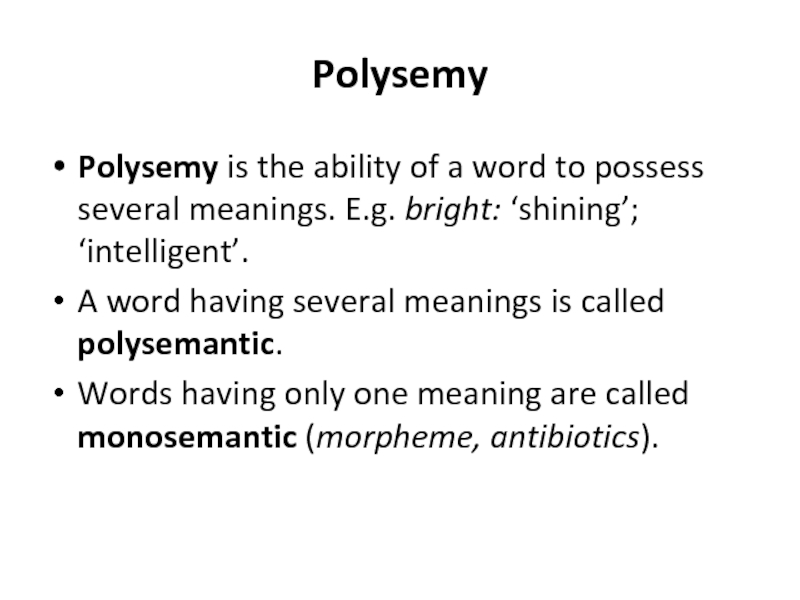
Слайд 15Lexico-semantic variant (A. I. Smirnitsky)
LSV is a two-sided unit, the material side
of which is the sound-form of a word, while the ideal side is one of the meanings of the given word.
The semantic centre of the word is the part of meaning which remains constant in all the lexico-semantic variants of the word.
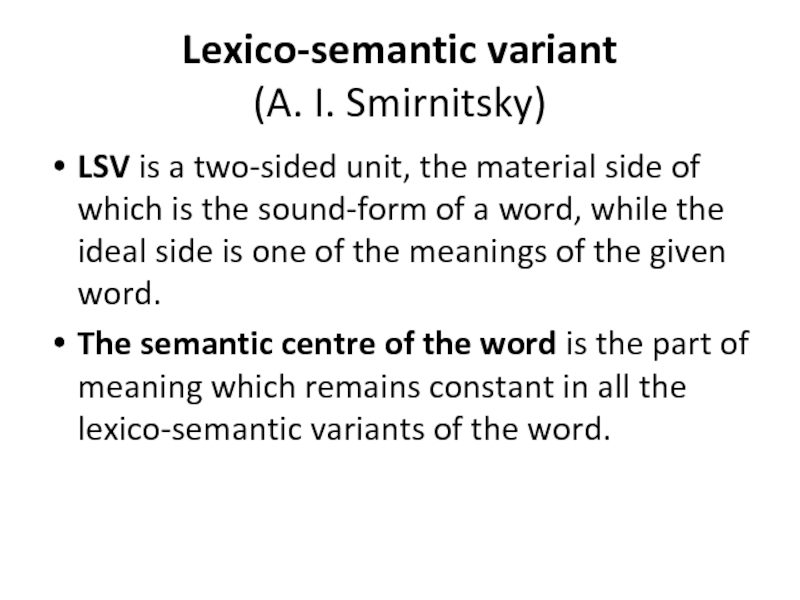
Слайд 16The semantic centre of the word
E.g. dull:
Boring – the deficiency in
interest
Stupid — the deficiency in intellect
Not clear or bright — the deficiency in colour
Not loud or distinct — the deficiency in sound
Not sharp — the deficiency in sharpness
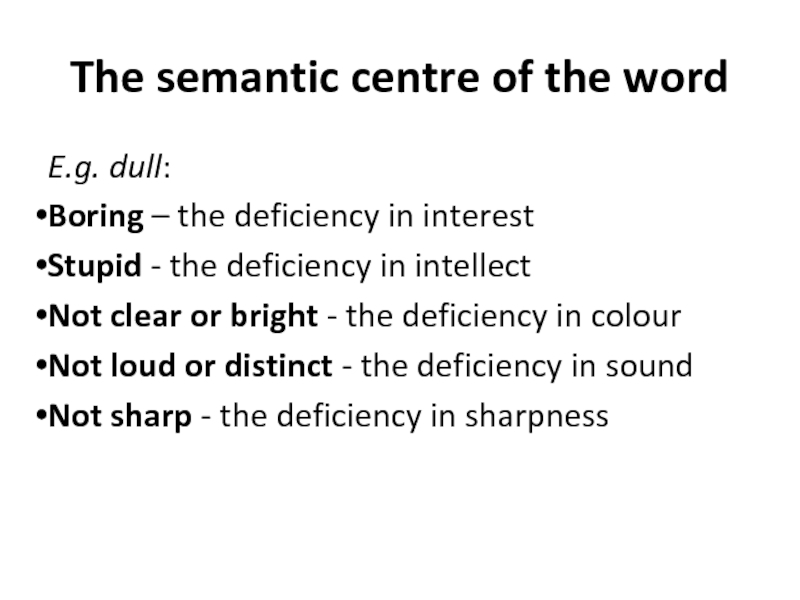
Слайд 17Diachronic perspective of polysemy
If polysemy is viewed diachronically it is understood
as the development of the semantic structure of the word.
Types of meaning:
the primary meaning
the secondary meaning
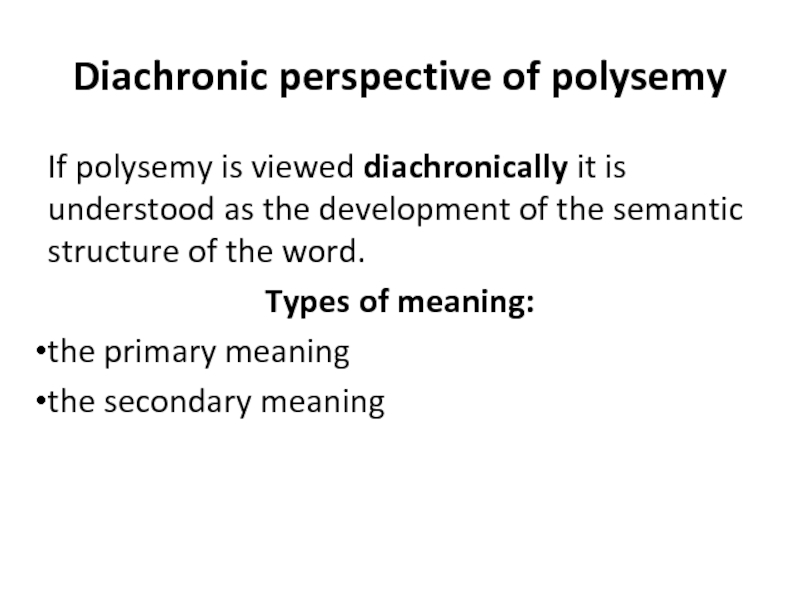
Слайд 18The primary meaning
e.g. table:
a piece of furniture;
people seating at
a table;
a meal;
a list of figures arranged in an ordered way (таблица);
a flat slab of stone or wood (плита)
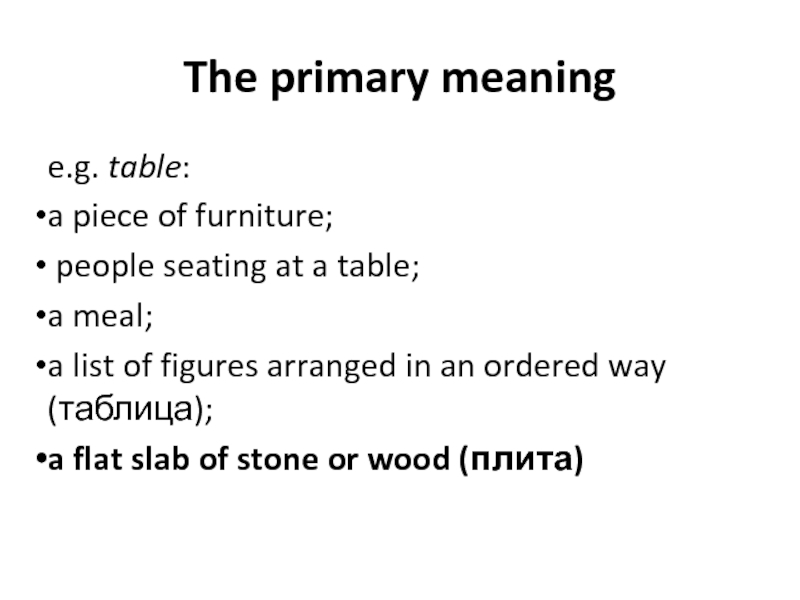
Слайд 19The synchronic perspective of polysemy
Synchronically polysemy is understood as the coexistence
of various meanings of the same word at a certain historical period of the development of the English language.
Types of meaning:
the central (basic) meaning
marginal (minor) meanings
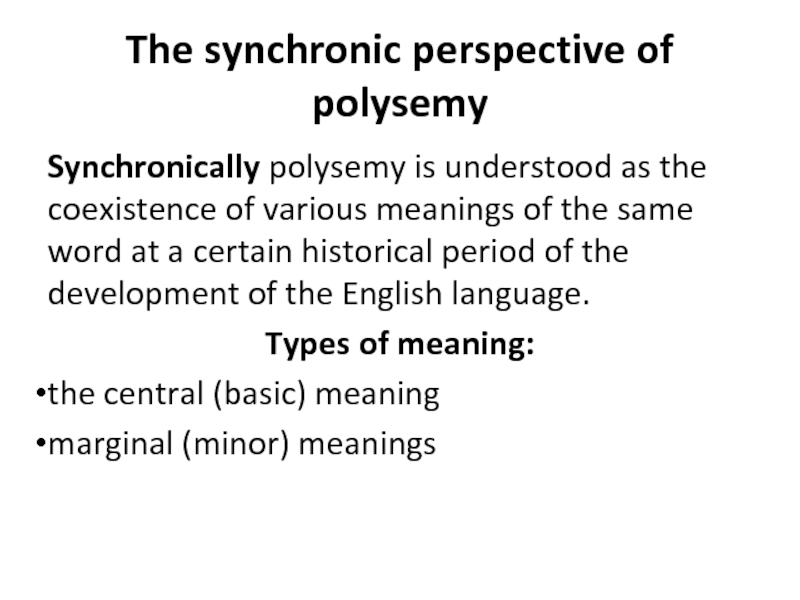
Слайд 20
The central (basic) meaning
The central meaning occurs in different contexts, possesses
the highest frequency of value, while marginal meanings are observed only in certain contexts and are less frequent.
E.g. table:
a piece of furniture;
people seating at a table;
a meal;
a list of figures arranged in an ordered way;
a flat slab of stone or wood
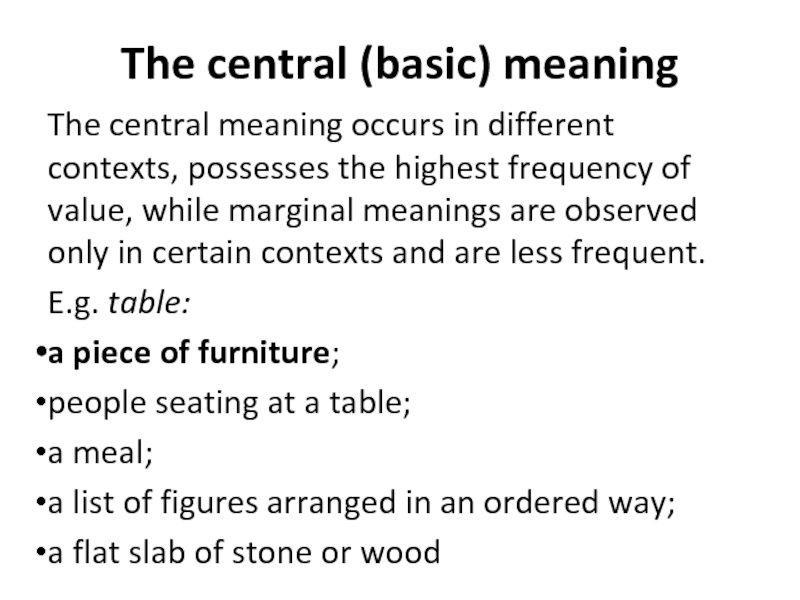
Слайд 21
Meaning and context
The actual meaning of a polysemantic word is revealed
through the context.
Context is the minimal stretch of speech determining each individual meaning of the word
Types of context:
linguistic
extra-linguistic
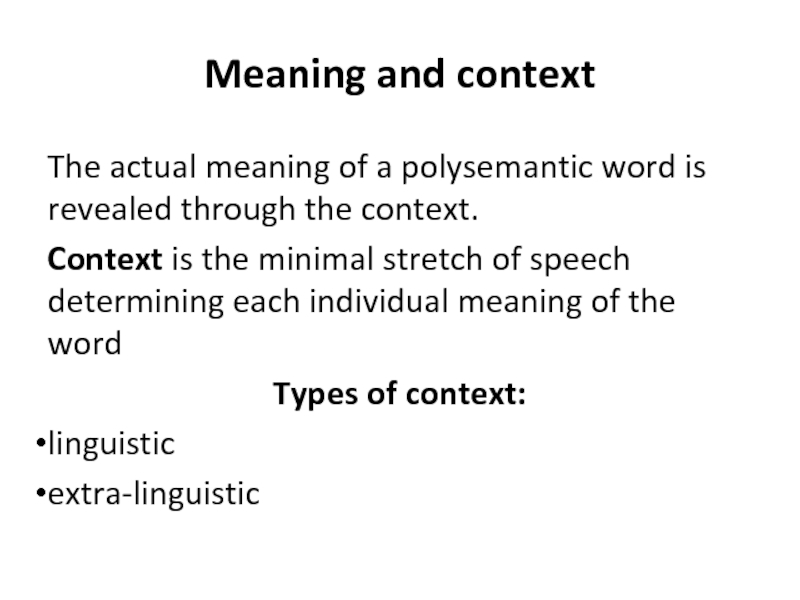
Слайд 22Linguistic contexts
lexical: the groups of lexical items are combined with
the polysemantic word under consideration.
E.g. heavy: ‘of great weight’ (heavy load, table); ‘abundant, striking, falling with force’ (heavy rain, storm, snow, wind); ‘the larger kind of smth’ (heavy industry, artillery, arms )
grammatical: the grammatical (syntactic) structure of the context serves to determine various individual meanings of a polysemantic word.
E.g. to make ‘to force, to induce’: to make + prn. + verb (to make smb. laugh, work, sit); ‘to become’: to make + adj. + noun (to make a good wife, a good teacher)
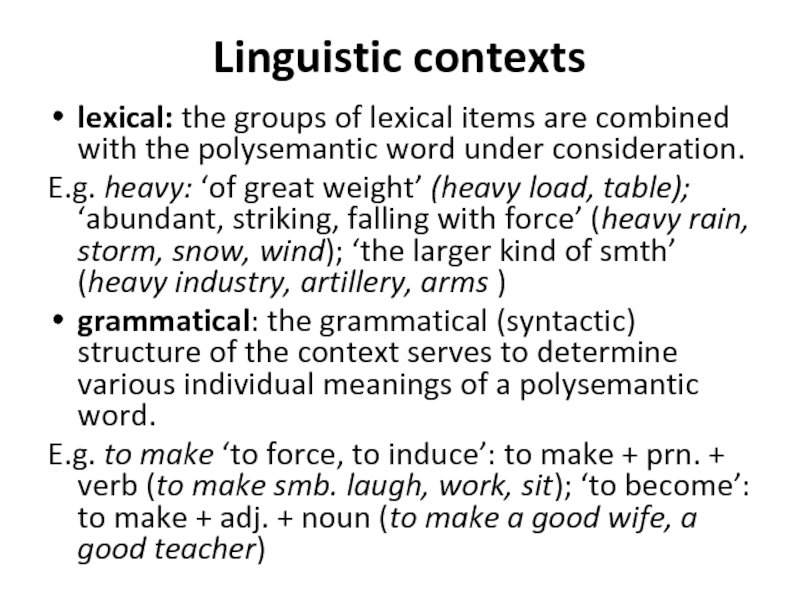
Слайд 23Extra-linguistic context
The meaning of a word is ultimately determined by the
actual speech situation in which the word is used.
E.g. The bill is large. (the meaning is ambiguous)
The bill is large but need not be paid. (the meaning is clear)
E.g. John was looking for the glasses. (the meaning is ambiguous)
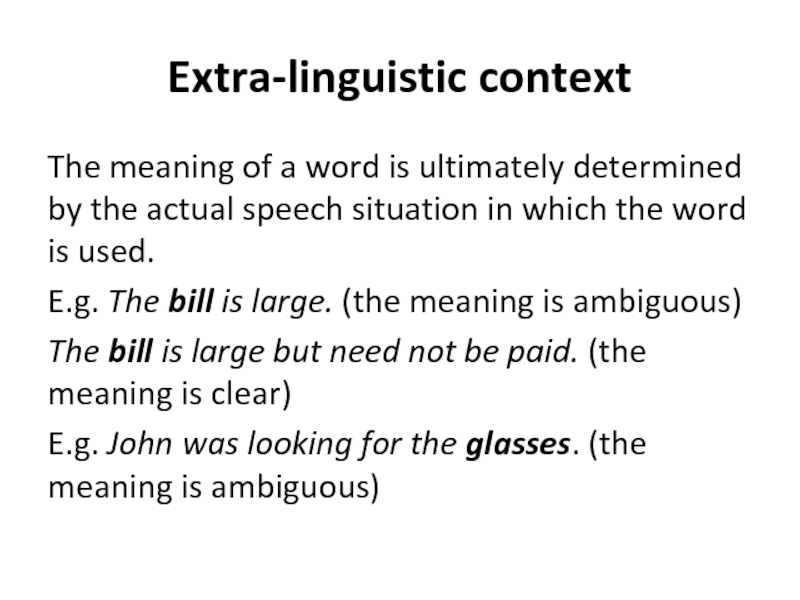
WORD-MEANING AND SEMANTIC STRUCTURE OF WORDS
1. Word-Meaning and Motivation.
2. Causes, Nature and Results of Semantic Change of Meaning.
3. Polysemy. Diachronic and Synchronic Approaches to Polysemy.
4. Polysemy and Context. Types of Context.
5. Homonymy. Classification of Homonyms.
Key words:motivation, semantic changes, ellipsis, fixed context, metaphor, metonymy, amelioration, deterioration, extension, specialization, pejoration, hyperbole, litotes, euphemism, polysemy, meaning, usage, lexico-semantic variant, semantic center, denotational component, connotational component, polysemantic word, monosemantic word, primary meaning, secondary meaning, diachronic approach, synchronical polysemy, central or basic meaning, marginal or minor meaning, context, homonyms, homophones, homographs
TASKS
1. Analyze the meanings of the given words. State what common associations, given by the graphic/sound-clusters sp-, -ash and gl- unite these words.
Sprinkle (to shake small amounts of a liquid over the surface of something), spray (to send liquid through the air in tiny drops either by the wind or some instrument), splash (to wet or soil by dashing masses or particles of water), spit (send liquid out from the mouth), spatter (to scatter drops of a liquid on a surface), spilt (to accidentally pour a liquid out of its container), spurt (if a liquid spurts from smth., it comes out in a sudden strong flow).
Smash (break violently into small pieces), dash (move or be moved violently), crash (strike suddenly violently and noisily), bash (to hit hard and violently), gash (a long deep cut or wound), slash (to move in a violent way that causes a lot of damage), trash (to criticize in a very strong way).
Glamour (a special quality that makes a person, place, or situation seem very exciting, attractive, or fashionable), gleam (a bright light reflected from something), glisten (to shine and look wet or oily), glossy (shiny in an attractive way), glint (to shine with quick flashes of light), glow (to shine with a soft light), glimmer (a soft weak light that is not steady).
2. Analyze the meanings of the italicized words. Group the words according to their type of motivation: a) words morphologically motivated; b) words semantically motivated.
Driver – someone who drives a vehicle, especially as his/her job; careless – not taking enough care; leg – the part of a piece of furniture such as a table or chair that supports it and raises it off the floor; horse – a piece of equipment shaped like a large box that is used in gymnastics; singlehood – the state of being single rather than married; wall – emotions or behaviour that prevent people from feeling close to each other; hand-made – made by hand, not machine; piggish – selfish; blue-eyed – having blue eyes; sound bite – a short comment by a politician or another famous person that is taken from a longer conversation or speech and broadcast alone because it is especially interesting or effective; leaflet – a small, often folded piece of printed paper, often advertising something, usually given free to people; streamlet – a small stream (a natural flow of water).
3. Define the kind of association involved in the semantic change.
Model: glass (a transparent solid substance used for making windows, bottles, etc.) – a glass (a container used for drinking, made of glass)
The kind of association involved in the semantic change in the words glass – a glass is known as metonymy or the contiguity of meaning.
1) the foot of a person – the foot of a mountain; 2) jean (heavy twilled cotton cloth, esp. denim) – jeans (trousers made of denim); 3) Matisse (proper name) – a Mattisse (a painting); 4) the wing of a bird – the wing of a building; 5) the key to a door – the key to a mystery; 6) copper (metal) – copper (coin); 7) the heart of a man – the heart of a city; 
10) China (a country) – china (dishes made of porcelain).
4. Analyze the meanings of the italicized words. Identify the result of changes of the denotational aspect of lexical meaning in the given words.
Model: loan: ‘a gift from a superior; a thing borrowed’ – ‘a sum of money which is borrowed, often from a bank, and has to be paid back, usually together with an additional amount of money that you have to pay as a charge for borrowing’
The result of the change of the denotational aspect of lexical meaning of the word loan is that the word became more specialized in meaning (restriction of meaning, specialization).
1) camp: „a place where troops are lodged in tents‟ – „a place where people live in tents or hunts‟; 2) girl: „a small child of either sex‟ – „a small child of the female sex‟; 3) bird: „a young bird‟ – „a creature with wings and feathers which can usually fly in the air‟; 4) arrive: „reach the shore after a voyage‟ – „reach a place at the end of a journey or a stage in a journey‟; 5) deer: „any quadruped (четверонога тварина)‟ –
„a hoofed grazing or browsing animal, with branched bony antlers that are shed annually and typically borne only by the male‟; 6) rug: „rough woolen stuff‟ – „a small carpet‟; 7) barn: „a place for keeping barley‟ – „a large farm building used for storing grain, hay, or straw or for housing livestock‟; 
enclosed by walls, floor, and ceiling‟; 10) fly: „move with wings‟ – „to move through the air or in the outer space‟; 11) artist: „master of the liberal arts (гуманітарні науки)‟ – „a person who produces paintings or drawings as a profession or hobby‟;
12) champion: „a fightingman‟ – „a person who has defeated or surpassed all rivals in
a competition, especially a sporting contest‟; 13) campaign: „army‟s operations in the
field‟– „a connected set of actions intended to obtain a particular result, in military
operations, in politics and business‟.
5. Analyze the meanings of the italicized words. Identify the result of the changes of the connotational aspect of lexical meaning in the given words.
Model: villain: ‘a feudal serf, peasant cultivator in subjection to a lord’ –‘a person guilty or capable of a crime or wickedness’
The result of the change of the connotational aspect of lexical meaning of the word villain is that the word acquired a derogatory emotive charge (deterioration of meaning).
1) cunning: „possessing erudition or skill‟ – „clever in deceiving‟; 2) knight:
„manservant‟ – „noble courageous man‟; 3) fond: „foolish, infatuated‟ – „loving,
affectionate‟; 4) gang: „a group of people going together‟ – „an organized group of
criminals‟;5) marshal: „manservant attendinghorses‟ – „an officer of the highest
rank in the armed forces‟; 6) coarse: „ordinary, common‟ – „rude or vulgar‟;
7) minister: „a servant‟ – „a head of a government department‟; 
propheticor poetic frenzy‟ – „intense and eager enjoyment, interest, or approval‟;
9) violent: „havinga marked or powerful effect‟ – „using or involving physical force
intended to hurt, damage, or kill someone or something‟; 10) gossip: „a godparent, a
person related to one in God‟ – „the one who talks scandal; tells slanderous stories
about other people‟.
6. Read the sentences in which the polysemantic word simple is used. Give all the lexico-semantic variants constituting the semantic structure of this word. Check yourself by a dictionary.
1. The book tries to give simple explanations of some very complex scientific ideas. 2. Sally likes clothes that are simple but elegant. 3. The simple fact is that he wants a divorce. 4. Archaeologists found several simple tools at the site. A knife is a simple tool. 5. Her grandparents were simple people who never had much money. I‟m just a simple farmer. 6. You may be joking but she‟s simple enough to believe you.
7. I‟m afraid old Jack is a bit simple.
7. Analyze the meanings of the given polysemantic words taken from the Concise Oxford Dictionary of English Etymology. These meanings are considered primary and central in Middle English. What are their basic (or central) meanings from the point of view of the present-day language?
Model: pension – ‘fixed or regular payment, spec. out of the revenues of a benefice’ (XIV c.)
In modern English the central meaning of the word is ‘a regular payment made by the state to someone who can no longer earn money by working’. Thus, in the present-day language the primary meaning of the word pension remains central.
1) likely – „probable‟ (XIII c.); 2) revolution – „moving of a celestial body in an orbit‟ (XIV c.); 3) to perish – „come to a violent or untimely end, cease to exist‟ (XIII c.); 4) challenge – „accusation‟ (XIII c.); 5) single – „unaccompanied, unmarried; individual; not double‟ (XIV c.); 6) to betray – „to give up treacherously‟ (XIII c.).
8. Classify the given words into: 1) homonyms proper; 2) homophones;
3) homographs. Give meanings of these words.
Made (adj) – maid (n); row (n) – row (n); week (n) – weak (adj); seal (n) – seal
(n); tear (v) – tear (n); bread (n) – bred (adj); band (n) – band (n); sum (n) – some
(pron); fall (n) – fall (v); wind (n) – wind (v); base (n) – base (v); desert (v) – desert
(n); hare (n) – hair (n); sewer (n) – sewer (n); corn (n) – corn (n).
9. Fill in the blanks choosing the right word.
1. Out of… out of mind (cite, site, sight). 2. Do not look a gift… in the mouth (horse, hoarse). 3. It never rains, but it… (pours, paws). 4. No… without sweat (sweet, suite). 5. Do not run with the… and hunt with the hounds (hair, hare). 6. All is… in love and war (fare, fair). 7. Fame is chiefly a matter of… at the right moment (die, dye). 8. When two people ride the…, one must ride behind (hoarse, horse).
|
Вычисление основной дактилоскопической формулы Вычислением основной дактоформулы обычно занимается следователь. Для этого все десять пальцев разбиваются на пять пар… |
Расчетные и графические задания Равновесный объем — это объем, определяемый равенством спроса и предложения… |
Кардиналистский и ординалистский подходы Кардиналистский (количественный подход) к анализу полезности основан на представлении о возможности измерения различных благ в условных единицах полезности… |
Обзор компонентов Multisim Компоненты – это основа любой схемы, это все элементы, из которых она состоит. Multisim оперирует с двумя категориями… |
1. Semantics
• Semantics (semasiology) is a branch of
lexicology that is devoted to the study of word
meaning.
• the semantics of a word = the meaning of a
word
2. Meaning
• a component of the word through which a
concept is communicated, thus enabling this
word to denote real objects, qualities and
abstract notions.
Two aspects of the word:
• the outer aspect, the material side of the
word (план выражения) (i.e. its sound form)
• the inner aspect, the ideal side of the word
(план содержания) (its meaning).
3. Types of meaning
• Grammatical meaning: tables, students,
houses, jokes — the grammatical meaning of
plurality.
The component of meaning recurrent in
identical sets of individual forms of different
words. E.g. the tense meaning (went,
answered, wrote), the case meaning (parents’,
sister’s, student’s, etc.).
4. Types of meaning
• Lexical meaning is identical in all the forms of
the word. E.g. write, writes, wrote, writing,
written.
• The meaning proper to the given linguistic
unit in all its forms and distributions
• Both the lexical and grammatical meanings
make up the word-meaning as neither can
exist without the other.
5. The components of meaning
• the denotative component (denotation)
• the connotative component (connotation)
6. The denotative component of meaning (denotation)
• is the principal part of meaning that makes
communication possible. It expresses the
conceptual content of a word.
• lonely: alone, without a company
• notorious: well known
• celebrated: well known
• to adore: to love
• to glare: to look
• to glance: to look
7. The connotative component of meaning (connotation)
• is what the word implies in addition to its
denotative meaning. It is the set of associations
that a word’s use can evoke.
• E.g. a hovel: “a small house” + “miserable, dirty,
in bad repair, unpleasant to live in”.
Types of connotation:
• emotive
• evaluative
• expressive (intensifying)
• pragmatic (i.e. connotation of duration, manner,
cause, etc.)
8. The connotative component
• lonely: unhappy (emotive connotation)
• notorious: about something bad (evaluative
connotation, negative)
• celebrated: about something good (evaluative
connotation, positive)
• to adore: deep feeling (expressive
connotation)
• to glare: steadily (connotation of duration) +
in angry, fierce way (emotive connotation)
• to glance: briefly (connotation of duration)
9. Denotative and connotative components
• Often a word’s connotation is fully explained
in the dictionary.
• Otherwise it can be realized through the
context.
E.g. Los Angeles is notorious for its smog.
• Denotative and connotative components
make up the semantic structure of a word.
10. Semantic Transfer
• The process of development of a new
meaning (or a change of meaning) is termed
transference.
Types of transference:
• metaphor
• metonymy
11. Metaphor
• Metaphor is a type of transference based on
the similarity of the objects, qualities or
phenomena denoted by the words.
Types of metaphor:
• similarity of shape: thus we can speak of the
eye of a needle
• position: head of a tree
• function: hands of a clock, etc.
12. Metonymy
• is based on the contiguity (смежность) of the
objects, qualities or phenomena denoted by the
words.
Types of metonymy:
• The name of the place — its inhabitants: school
• Quality — the subject of this quality: beauty
Material — the product made of this material:
bronze, clay, silver
• Animal – the meat of this animal: fowl, turkey
Action – the subject of the action: safeguard,
support
13. Results of semantic change
Change of the denotative component:
• broadening (generalization) of meaning: bird,
pipe
• narrowing (specialization) of meaning: hound, girl
Change of the connotative component:
• Elevation of meaning (the improvement of the
connotative component of meaning): minister,
knight
• Degeneration of meaning (the acquisition by the
word of some derogatory emotive charge): boor,
silly
14. Polysemy
• Polysemy is the ability of a word to possess
several meanings. E.g. bright: ‘shining’;
‘intelligent’.
• A word having several meanings is called
polysemantic.
• Words having only one meaning are called
monosemantic (morpheme, antibiotics).
15. Lexico-semantic variant (A. I. Smirnitsky)
Lexico-semantic variant
(A. I. Smirnitsky)
• LSV is a two-sided unit, the material side of
which is the sound-form of a word, while the
ideal side is one of the meanings of the given
word.
• The semantic centre of the word is the part of
meaning which remains constant in all the
lexico-semantic variants of the word.
16. The semantic centre of the word
E.g. dull:
• Boring – the deficiency in interest
• Stupid — the deficiency in intellect
• Not clear or bright — the deficiency in colour
• Not loud or distinct — the deficiency in sound
• Not sharp — the deficiency in sharpness
17. Diachronic perspective of polysemy
If polysemy is viewed diachronically it is
understood as the development of the semantic
structure of the word.
Types of meaning:
• the primary meaning
• the secondary meaning
18. The primary meaning
e.g. table:
• a piece of furniture;
• people seating at a table;
• a meal;
• a list of figures arranged in an ordered way
(таблица);
• a flat slab of stone or wood (плита)
19. The synchronic perspective of polysemy
Synchronically polysemy is understood as the
coexistence of various meanings of the same
word at a certain historical period of the
development of the English language.
Types of meaning:
• the central (basic) meaning
• marginal (minor) meanings
20. The central (basic) meaning
The central meaning occurs in different contexts,
possesses the highest frequency of value, while
marginal meanings are observed only in certain
contexts and are less frequent.
E.g. table:
• a piece of furniture;
• people seating at a table;
• a meal;
• a list of figures arranged in an ordered way;
• a flat slab of stone or wood
21. Meaning and context
The actual meaning of a polysemantic word is
revealed through the context.
Context is the minimal stretch of speech
determining each individual meaning of the
word
Types of context:
• linguistic
• extra-linguistic
22. Linguistic contexts
• lexical: the groups of lexical items are combined
with the polysemantic word under consideration.
E.g. heavy: ‘of great weight’ (heavy load, table);
‘abundant, striking, falling with force’ (heavy rain,
storm, snow, wind); ‘the larger kind of smth’ (heavy
industry, artillery, arms )
• grammatical: the grammatical (syntactic)
structure of the context serves to determine
various individual meanings of a polysemantic
word.
E.g. to make ‘to force, to induce’: to make + prn. +
verb (to make smb. laugh, work, sit); ‘to become’:
to make + adj. + noun (to make a good wife, a good
teacher)
23. Extra-linguistic context
The meaning of a word is ultimately determined
by the actual speech situation in which the word
is used.
E.g. The bill is large. (the meaning is ambiguous)
The bill is large but need not be paid. (the
meaning is clear)
E.g. John was looking for the glasses. (the
meaning is ambiguous)







